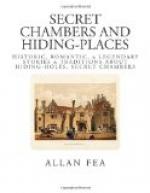Cussans, in his History of Hertfordshire, gives a curious account of the discovery of an iron door up the kitchen chimney of the old house Markyate Cell, near Dunstable. A short flight of steps led from it to another door of stout oak, which opened by a secret spring, and led to an unknown chamber on the ground level. Local tradition says this was the favourite haunt of a certain “wicked Lady Ferrers,” who, disguised in male attire, robbed travellers upon the highway, and being wounded in one of these exploits, was discovered lying dead outside the walls of the house; and the malignant nature of this lady’s spectre is said to have had so firm a hold upon the villagers that no local labourer could be induced to work upon that particular part of the building.
Beare Park, near Middleham, Yorkshire, had a hiding-hole entered from the kitchen chimney, as had also the Rookery Farm, near Cromer; West Coker Manor House; and The Chantry, at Ilminster, both in Somerset. At the last named, in another hiding-place in the room above, a bracket or credence-table was found, which is still preserved.
Many weird stories are told about Bovey House, South Devon, situated near the once notorious smuggling villages of Beer and Branscombe. Upon removing some leads of the roof a secret room was found, furnished with a chair and table. The well here is remarkable, and similar to that at Carisbrooke, with the exception that two people take the place of the donkey! Thirty feet below the ground level there is said to have been a hiding-place—a large cavity cut in the solid rock. Many years ago a skeleton of a man was found at the bottom. Such dramatic material should suggest to some sensational novelist a tragic story, as the well and lime-walk at Ingatestone is said to have suggested Lady Audley’s Secret.
A hiding-place something after the same style existed in the now demolished manor house of Besils Leigh, Berks. Down the shaft of a chimney a cavity was scooped out of the brickwork, to which a refugee had to be lowered by a rope. One of the towers of the west gate of Bodiam Castle contains a narrow square well in the wall leading to the ground level, and, as the guide was wont to remark, “how much farther the Lord only knows”! This sort of thing may also be seen at Mancetter Manor, Warwickshire, and Ightham Moat, Kent, both approached by a staircase.
A communication formerly ran from a secret chamber in the oak-panelled dining-room of Birtsmorton Court, Worcestershire, to a passage beneath the moat that surrounds the structure, and thence to an exit on the other side of the water. During the Wars of the Roses Sir John Oldcastle is said to have been concealed behind the secret panel; but now the romance is somewhat marred, for modern vandalism has converted the cupboard into a repository for provisions. The same indignity has taken place at that splendid old timber house in Cheshire, Moreton Hall, where a secret room, provided with a sleeping-compartment, situated over the kitchen, has been modernised into a repository for the storing of cheeses. From the hiding-place the moat could formerly be reached, down a narrow shaft in the wall.




